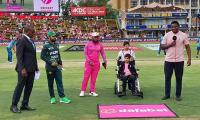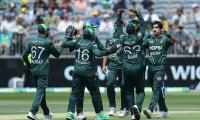Former prime minister and PML-N leader Nawaz Sharif has once again been elected as party president unopposed.
Nawaz has returned to the party’s coveted position six years after he lost the office due to a Supreme Court decision. Now he will legally lead the party. The former PM is taking over the party at a time when the PML-N is facing serious political challenges.
Before we talk about the challenges faced by Nawaz Sharif in his new role, let’s start with how lucky he is as a politician.
Nawaz is lucky because he has been able to make his second comeback in active politics. He was disqualified for life by the SC in the Panama case, followed by his removal as the president of the party. He was convicted in NAB cases and imprisoned. He was then allowed to leave the country on medical grounds.
His opponents had claimed that his politics was finished and he would not be able to come back. But he proved them wrong. He returned to the country a few months before the February 8 general elections. His convictions were overturned, and he was allowed to contest the elections. While he failed to become prime minister for the fourth time, it was still a remarkable comeback.
Nawaz’s recent return is similar to what happened in 1999, when the late Pervez Musharraf ousted him in a military coup. He went to Saudi Arabia after a deal with the military regime. He tried to return but was sent back. Musharraf used to say that he would never allow Shaheed Benazir Bhutto and Nawaz Sharif to return to the country, as the chapters of both politicians had been closed. In 2007, both Nawaz Sharif and BB Shaheed returned to the country to lead the election campaigns of their respective parties. However, luck was not in Benazir’s favour who was assassinated in Rawalpindi during one such campaign.
Nawaz Sharif made a strong comeback in the 2013 general elections and became prime minister for the third time. He led the government from 2013 to July 2017 until his ouster from power.
Now let’s discuss the challenges faced by Nawaz Sharif as the PML-N president. The aging politician is not in a position to make mistakes. His party stands at a crossroads, and it still needs time to recover from the setbacks it suffered in the general elections.
The first challenge before Nawaz is to regain lost ground in Punjab and reorganize the party. The PML-N lost many constituencies in the urban centres of Punjab, where it was expected to perform better. It lost constituencies in its strongholds in central Punjab, besides losing its popular vote bank in many districts of Punjab.
Nawaz needs to come to terms with the fast changing electoral dynamics in Punjab and Khyber Pakhtunkhwa (KP). In both provinces, the traditional vote bank of clans, tribes and influential candidates is on the decline, while the popular vote bank is rising. The dynamics of urban constituencies are changing fast. The trend of block voting is breaking down with the weakening of the joint family system in cities. Young voters are becoming much more important as their numbers continue to grow.
The other factor is the changing political trends among the middle class. The PML-N was once the favourite party of the middle class. But since the rise of the PTI, the party has lost a big chunk of professional, urban middle-class voters. It is now relying mainly on middle-class traders and industrialists. An overwhelming majority of the urban upper middle class and layers of the professional middle class are not supporting the PML-N any more.
The PML-N enjoyed solid support from poor sections of the urban population after the decline of the PPP. But in the last two elections, the TLP has been able to make inroads into sections of more religious, poor voters.
Nawaz needs to strengthen the party nationally. He must focus on Karachi in Sindh and Hazara in KP.
The second challenge for Nawaz is to build an attractive and popular narrative. In the recent elections, his party failed to attract independent and young voters with the ‘Pakistan ko Nawaz do’ narrative. In the 2018 elections, for example, the party had a strong ‘vote ko izzat do’ narrative. Developing an attractive and catchy narrative while in power is a serious challenge. Nawaz needs to let go of the past and present a future of hope.
The PML-N needs a clear roadmap for the future instead of repeating past injustices and successes. It needs a clear reform agenda to win back sections of the population it has lost. The victim narrative might be attractive for PML-N supporters but not for independent voters, especially young voters.
The third challenge for Nawaz Sharif is the performance of the Punjab government led by his daughter Maryam Nawaz and the federal government led by his younger brother Shahbaz Sharif. A lot depends on the performance and delivery of the two governments to revive the political fortunes of the PML-N as a political party.
Nawaz Sharif might not be able to do much about the party’s revival, if both governments fail to perform better and fulfil the promises made during the election campaign.
In the 2024 elections, the PML-N lost popular support among sections of society due to the poor performance of the Shehbaz Sharif-led PDM government that came into power after the ouster of Imran Khan. The party is not in a position to burn more political capital while in power.
Poverty, rising unemployment, runaway inflation and the never-ending economic crisis are the major issues faced by the PML-N-led government. Its economic performance will decide the political future of the PML-N.
The writer is a freelance journalist.
There are over 11 million Pakistanis settled abroad, out of which around six million work in Gulf and Middle East
This year alone, US Treasury would have to roll-over $10 to $14 trillion in maturing short-term debt
Tear gas no longer marks just protest sites; it paints entire cities as battlegrounds but then again, PTI did it first
Political structures and governance systems have been central to economic and social development
It is confirmed now 40 Pakistanis had died after boat of migrants had capsized in sea near Greece
Many people believe that in future, AI will play an even more significant role in their lives







